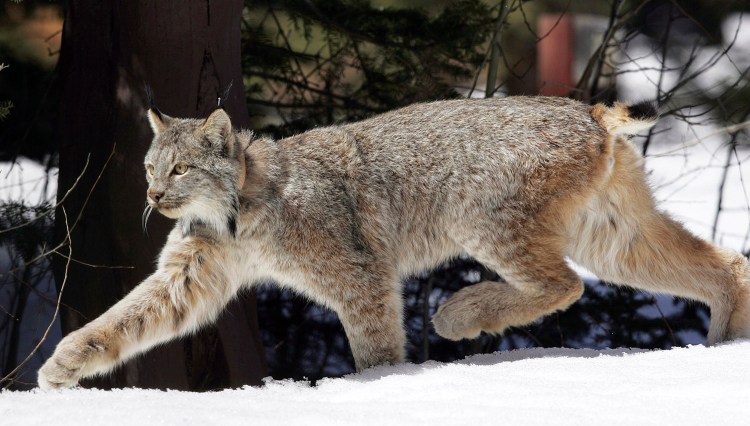MONTPELIER, Vt. — Researchers are still surveying for Canada lynx in northern Vermont and New Hampshire after evidence of a family of the federally threatened animals was discovered in 2012 and 2013, the first time in Vermont’s history that a reproductive lynx had been documented.
Biologists found tracks as well as scat and hair from a family of three, possibly four, animals traveling together in the Nulhegan Basin in northeastern Vermont in the winter of 2012. The following winter, tracks of a family of four were spotted but no DNA evidence was found.
“What’s newsworthy is that it’s definitively reproduction. So that was the first time in Vermont’s history we have ever documented reproduction of lynx,” said Chris Bernier, furbearer biologist for the state Department of Fish and Wildlife.
Biologists suspect that a decline in Maine of the population of snowshoe hares – the primary food source for lynx – has caused some of the snow-loving big cats to travel to the southern edge of their range into northern Vermont and New Hampshire.
Researchers have not seen evidence of reproducing lynx in the two states since then, but a single lynx was photographed in the Nulhegan Basin in 2014 and tracks have been found in Pittsburg, New Hampshire, where in 2011 four lynx kittens were captured on video.
“Along with the knowledge that we had reproduction comes the obligation and the excitement … to make sure that we’re properly accounting for these animals and providing protection and making sure that we’re doing what we can to help them persist,” Bernier said.
Aside from the Nulhegan Basin in the Silvio O. Conte National Wildlife Refuge in the Ferdinand, Brunswick and Lewis areas, biologists have also surveyed an area about 30 miles to the south that is suitable habitat for the animals – the Victory Basin, in Victory, Vermont. Both areas are lowland, spruce-fir dominated basins that are boreal in nature, which are rare habitats in Vermont but common north of the border, Bernier said. The areas have deep snow, long winters and abundant snowshoe hares.
In addition to annual surveys for tracks in winter in northern Vermont and Pittsburg, New Hampshire, researchers have set up cameras in those areas and in the White Mountains, and not all the cameras from this past winter in New Hampshire have been checked yet.
The animals disappeared from New Hampshire in the late 1960s, which biologists suspect was due to habitat changes and overtrapping. The state Fish and Game Department has picked up signs of the animals in Coos County over the last dozen years and had a few occurrences of lynx in the White Mountain National Forest in 2012-2013, said Jill Kilborn, a New Hampshire Fish and Game assistant regional biologist based in Lancaster.
Clearcutting in Maine in the 1970s and ’80s – in large part to eradicate spruce budworm –created prime habit for snowshoe hares, which caused the lynx population to grow. Estimates from federal scientists put the number of Canada lynx in Maine at 500; that’s fewer than a state estimate of 750 to 1,000 lynx about five years ago.
Scientists say lynx face challenges in New Hampshire, Vermont and areas outside of northern Maine, such as competition from other species, like bobcats and fishers, fragmented habitat and warming trends.
“There’s potentially times when conditions might be just right that lynx can occur in Vermont and New Hampshire and in western Maine and Downeast Maine but probably not consistently,” said Mark McCullough, an endangered species biologist with the U.S. Fish and Wildlife Service in Orono, Maine.
Send questions/comments to the editors.



Success. Please wait for the page to reload. If the page does not reload within 5 seconds, please refresh the page.
Enter your email and password to access comments.
Hi, to comment on stories you must . This profile is in addition to your subscription and website login.
Already have a commenting profile? .
Invalid username/password.
Please check your email to confirm and complete your registration.
Only subscribers are eligible to post comments. Please subscribe or login first for digital access. Here’s why.
Use the form below to reset your password. When you've submitted your account email, we will send an email with a reset code.